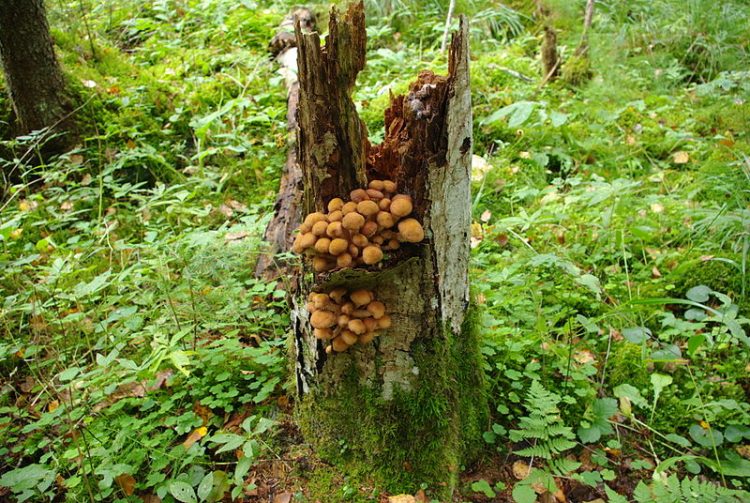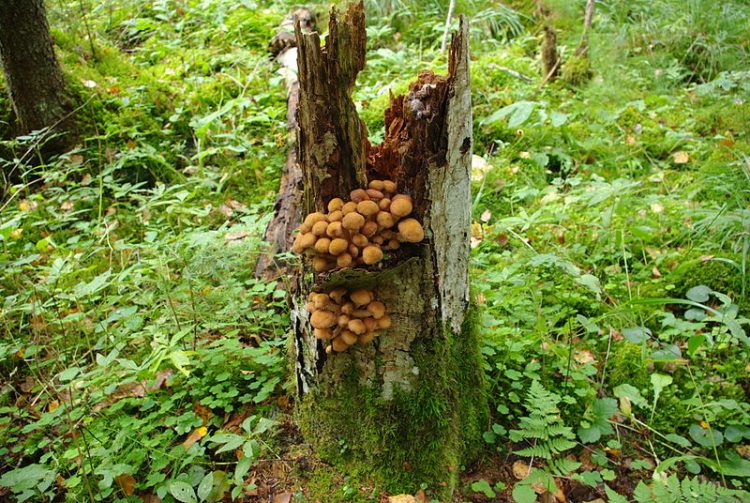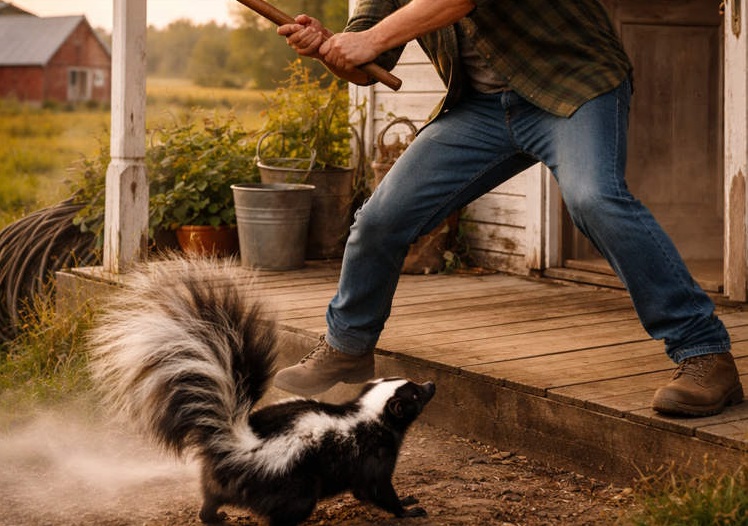In the Blue Mountains of eastern Oregon lurks one of the strangest and oldest known organisms on planet Earth- a giant fungus that has been around for over 2,400 years. Armillaria ostoyae, also known as the “shoestring fungus” or “honey mushrooms”, covers an area of 2200 acres, or 3 square miles, making it the largest organism ever discovered. It began its life cycle as a single spore, too small to be seen by the naked eye, and is estimated to have been slowly spreading for at least the past two and a half millennia, although some experts estimate that it is around 8000-years-old.
The giant fungus spreads through the root system of the forest under which it resides and slowly kills whatever is in its path, making it not only the largest organism on the planet but also one of the most deadly. For a few weeks each autumn, the honey mushroom erupts in yellowish clusters with caps, gills and spores, but the rest of the year it takes the shape of a thin white layer, similar to latex paint. It is in this less conspicuous form, however, that the fungus is most lethal, as it can spread more easily through the trees.

Photo: Antrodia
Trees often benefit from the presence of mushrooms at their roots, as the fungus helps move nutrients through the soil. Honey mushrooms are not like other mushrooms, though. It spreads up under the tree bark and rots the roots, slowly sucking the life out of the tree over the course of decades. The trees attempt to fight the parasitic fungus by oozing pitch from their bark, but they are fighting a losing battle.
“People don’t think of mushrooms killing trees,” Greg Filip, a pathologist with the U.S. Forest Service, told Oregon Public Broadcasting. “The fungus will grow all the way around the base of the tree and then kills all the tissues. It could be 20, 30, 50 years maybe before it finally dies. Then there’s no movement of water or nutrients up and down the tree when that happens,”

Photo: Neilmaceachern
Armillaria ostoyae was first discovered in 1988 by forest service employee Greg Whipple. He initially thought the fungus only covered 400 acres, but over time realized it was much bigger than that. The forest service dug out samples from many areas in the forest, and everywhere they found more fungus. Initially, it seemed to be the same type of fungus, but further DNA testing revealed that it was, in fact, a single living organism. They calculated that if it were to be collected in one pile, the fungus would weigh at least 7,500 tons, and potentially as much as 35,000 tons, or the combined weight of 200 gray whales.
“We haven’t seen anything else in the literature that would suggest that anything else in the world is larger in acreage,” Greg Filip said.

Photo: Dohduhdah
This humongous fungus has been around far longer than the state and country under which it lives.
The honey mushroom can be found in other parts of the world, like Michigan and Germany, but the one in Oregon is the largest and oldest ever measured.
“When you realize this fungus spreads at one to three feet a year and you have something that large, you can calculate the age,” Filip said. “And we’re looking at something anywhere from 2,000-to-8,000 years old.”
Scientists may find it fascinating, but the local timber industry hates this fungus with a vengeance. It has been destroying their precious wood for as long as anyone can remember, but they have yet to come up with an effective way to stop it. In the 1970s, researchers attempted to eliminate the fungus entirely on several test plots at a timber farm. They cut down trees, dug out stumps, and in some areas raked out every last fiber they could find. The final method produced the best results throughout the 40-year study, as more pine trees survived after being planted on the treated ground. However, that approach was also labor intensive, expensive, and not feasible on the scale necessary to eliminate the massive fungus. Timber companies could not possibly dig out every trace of the organism.

Photo: Google Earth
Dan Omdal, with the Washington Department of Natural Resources, is trying another approach. He and his team have planted several different species of conifers near the stump of a tree killed by Armillaria, with the hope that at least one will tolerate the fungus.
“We’re looking for a tree that can grow in its presence. It’s foolish to plant the same species where you harvested in areas that are infested by the disease,” Omdal told OPB.
Humans will not have much of an impact on the mushroom whatever the approach, as it lives on such a massive scale, under entire forests. It is a part of the landscape, and is merely Nature at work, killing trees and recycling them back into the soil.
“There’s a wildlife benefit to these trees,” Dr. Filip said to OPB. “Once they’re dead, they decay, the birds begin to excavate them and use them for cavities.”













